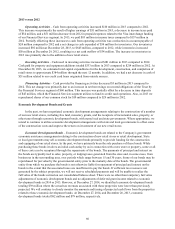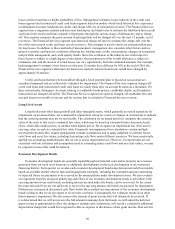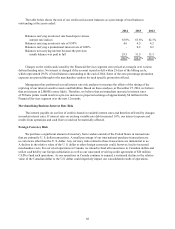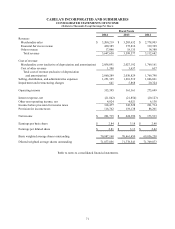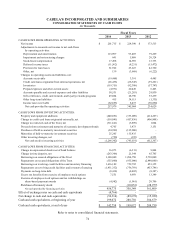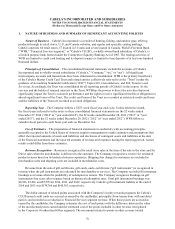Cabela's 2014 Annual Report Download - page 76
Download and view the complete annual report
Please find page 76 of the 2014 Cabela's annual report below. You can navigate through the pages in the report by either clicking on the pages listed below, or by using the keyword search tool below to find specific information within the annual report.66
losses as these loans have a higher probability of loss. Management estimates losses inherent in the credit card
loans segment and restructured credit card loans segment based on models which track historical loss experience
on delinquent accounts, bankruptcies, death, and charge-offs, net of estimated recoveries. The Financial Services
segment uses a migration analysis and historical bankruptcy and death rates to estimate the likelihood that a credit
card loan in the credit card loans segment will progress through the various stages of delinquency and to charge-
off. This analysis estimates the gross amount of principal that will be charged off over the next 12 months, net of
recoveries. The Financial Services segment uses historical charge-off rates to estimate the charge-offs over the
life of the restructured credit card loan, net of recoveries. This estimate is used to derive an estimated allowance
for loan losses. In addition to these methods of measurement, management also considers other factors such as
general economic and business conditions affecting key lending areas, credit concentration, changes in origination
and portfolio management, and credit quality trends. Since the evaluation of the inherent loss with respect to
these factors is subject to a high degree of uncertainty, the measurement of the overall allowance is subject to
estimation risk, and the amount of actual losses can vary significantly from the estimated amounts. For example,
had management’s estimate of net losses over the next 12 months been different by 10% at the end of 2014, the
Financial Services segment’s allowance for loan losses and provision for loan losses would have changed by
approximately $6 million.
Credit card loans that have been modified through a fixed payment plan or placed on non-accrual are
considered impaired and are collectively evaluated for impairment. The Financial Services segment charges off
credit card loans and restructured credit card loans on a daily basis after an account becomes at a minimum 130
days contractually delinquent. Accounts relating to cardholder bankruptcies, cardholder deaths, and fraudulent
transactions are charged off earlier. The Financial Services segment recognizes charged-off cardholder fees and
accrued interest receivable in interest and fee income that is included in Financial Services revenue.
Long-Lived Assets
Long-lived assets other than goodwill and other intangible assets, which generally are tested separately for
impairment on an annual basis, are evaluated for impairment whenever events or changes in circumstances indicate
that the carrying amount may not be recoverable. The calculation for an impairment loss compares the carrying
value of the asset to that asset’s estimated fair value, which may be based on estimated future discounted cash
flows, observable market prices, or unobservable market prices. We recognize an impairment loss if the asset’s
carrying value exceeds its estimated fair value. Frequently our impairment loss calculations contain multiple
uncertainties because they require management to make assumptions and to apply judgment to estimate future
cash flows and asset fair values, including forecasting cash flows under different scenarios. We have consistently
applied our accounting methodologies that we use to assess impairment loss. However, if actual results are not
consistent with our estimates and assumptions used in estimating future cash flows and asset fair values, we may
be exposed to losses that could be material.
Economic Development Bonds
Economic development bonds are generally repaid through incremental sales and/or property tax revenues
generated from our retail store locations or additional developments in the local development or tax increment
financing district. Each quarter we revalue each economic development bond using discounted cash flow models
based on available market interest rates and management estimates, including the estimated amounts and timing
of expected future tax payments to be received by the municipalities under development zones. We also evaluate
on a quarterly basis the projected underlying cash flows of our economic development bonds to determine if the
carrying amount of any such bonds, including interest accrued under the bonds, can be recovered. To the extent
the expected cash flows are not sufficient to recover the carrying amount, the bonds are assessed for impairment.
Deficiencies in projected discounted cash flows below the recorded carrying amount of the economic development
bonds evidences that we do not expect to recover the cost basis. Consequently, the valuation results in an other
than temporary impairment. We also reassess the amount of grant income that will ultimately be received. If
it is determined that we will not receive the full amount remaining from the bonds, we will adjust the deferred
grant income to appropriately reflect the change in estimate and, at that time, will record a cumulative additional
depreciation charge that would be recognized to date as expense in the absence of the grant income. Had our fair






